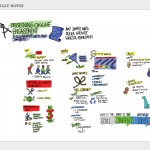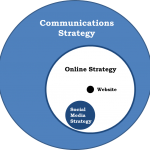photo courtesy Dimitri Petropolis
We can create the future we want if we revise our approach to how we strive for change according to Hildy Gottlieb.
In July, Gottlieb lead a session in Waterloo Region that challenged participants to take a fresh look at how we make our communities and our world better. As a force behind Creating the Future, it’s become Gottlieb’s life work.
What follows are some of my key takeaways from participating in this session combined with some of my own insights. By sharing them, I trust that they might provoke you to consider your own approach to pursuing change.
Collaborative initiatives fail when we don’t know each other as people
This statement seems so obvious at first but how often do we realize that not knowing each other as people is the issue. Yet if you look back at collaborative efforts, with other organizations or even internal team members, you likely realize how little the folks participating knew each other as people. We might know their name, role and organization but how often does it go beyond that? Do you find your efforts are more successful when you know the people working with you on a project?
What makes them tick? What brings out their passion? What stresses and pressures do they face at work or at home? How did they come to be in the place where they are working with you? Where are they trying to go?
These are some of the questions that help us go beyond the surface and make the connections with other people that’s necessary to work successfully together.
Start by agreeing on what you’re trying to achieve
Gottlieb believes the best way to create the future we want is to determine what that future is. Then work backwards to figure out the steps necessary to get there.
I shared with her at the end that one of my strengths was identifying a desired result. My experience though is that the common response of others is to identify barriers that they perceive as insurmountable roadblocks whereas I’m a big believer in where there’s a will there’s a way. To me, barriers are only factors that have been identified and need to be considered in determining how to achieve the desired result.
I told her I could see the merits of her backward planning approach. My experience comes from trying to plan how to move forward as is the most common approach to determining how to achieve change. Doing so though is so based upon our current context which leads us to focus on issues and problems (i.e. barriers) in the way even if we agree the end goal is desirable.
Gottlieb’s approach is that when we work together and plan backward we identify those same issues and problems but we naturally look at them as a factor to be considered and we figure out how to take them into account. The shared value of the future we’re creating makes it the priority and opens our minds to how to get there.
As she points out, it’s not anything new. We regularly plan backwards to achieve success-just not normally to create change in our communities or society. But it’s a natural part of how we live our personal lives such as what we need to know and do to be ready to attend a friend’s birthday party or professionally when we create a critical path to get our annual report done in time for the Annual General Meeting.
We just need to apply to same planning skills to creating the future we desire.
think about what we can accomplish together that we can’t alone
Collaboration was an overarching theme.
Whether as individuals or organizations, are we achieving the change we want to see. If we’re being truly honest, the answer is almost always no.
The conclusion is that if we want to break out of the status quo and achieve our goals we need to work differently. For organizations especially in the social profit sector that means moving beyond our own mission and vision and working with others to get results we could not achieve on our own. I believe that the Waterloo Region Crime Prevention Council is a great example of this collaborative approach. Its best example is the inREACH program that saw member organization’s coming together to implement a successful program to get kids to make better choices than to join gangs.
Individuals can also benefit from thinking this way. After all, that’s what lead to the creation of many social profit organizations! But even informally, we likely find ways we can benefit and create a better future if we find ways to work together than working independently.
I recognize though that doing so as organizations or individuals is often difficult. Even for myself at times. But if we can change the way we think and just get started, I suspect we can achieve more and in a shorter period of time.
More Posts on How people can create the future
There were several other stops on Gottlieb’s tour of southern Ontario. If I’ve piqued your interest, I suggest that you read these posts by Renjie Butalid and Allyson Hewitt.






